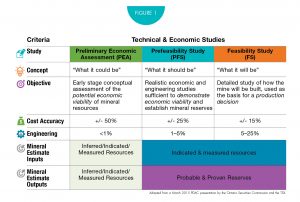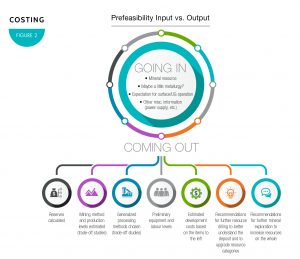Strategies for acquiring make-or-break cost data
Costs are an inherent aspect of evaluating, advancing and generating profits from any mining property. They often make or break projects and are typically the final stop before “go/no go” development decisions are made. As such, costs, in some form or another, are one of the biggest topics of discussion in the mining industry. Despite that fact, I would also suggest that the process for obtaining costs is one of the least discussed topics in our industry.
The process of obtaining cost data for early stage (prefeasibility level) mine development projects is an important one. Several questions should be addressed, including:
- When should costs be obtained/considered? • How is the cost data to be utilized? • What costs are needed?
- What accuracy is needed for costs to be useful to the estimator?
- What hurdles must be overcome to obtain costs?
- Are there specific strategies for obtaining cost data?
NOTE: a cost estimator may be someone dedicated to the task or it may be a mining engineer or geologist responsible for development decisions related to the property.
Understand what prefeasibility means
An obvious generic answer to when costs should be obtained and considered might be “on-going,” but for prefeasibility costing the true answer is “when you have a measured and indicated resource.” Exploration stage properties or properties with only an inferred resource do require cost considerations (scoping or preliminary economic analysis [PEA]) but they are still too speculative and provide only a hint of what could be. Similarly, if much of your engineering work is complete and of final feasibility detail (feasibility study [FS]), you’ve waited too long and possibly sunk unnecessary costs into the project. Figure 1 highlights the parameters for each study level.
While these comments may seem rudimentary, the reality is that many in our industry do not fully understand the concept of prefeasibility. It is the author’s opinion that prefeasibility is the point at which you have enough scientific data in hand that you can safely say, “I’ve really got something here!” If you will notice, I have indicated that prefeasibility is contingent upon the amount of scientific data in hand, not engineering data. Generally speaking, when entering a prefeasibility level study, your project will have had very little engineering completed.
This is important to remember because the input data is all you will have to work with when we talk about the hurdles that must be overcome to obtain costs.
 Hurdles to obtaining cost data
Hurdles to obtaining cost data
The output side of a prefeasibility level project provides insight as to what costs are needed and how the costing data is utilized. For example, for a pre-feasibility level project, preliminary equipment lists and subsequent development costs are derived based on the results of trade-off studies for proposed mining and processing methods (Figure 2). Unfortunately, one of the larger tasks encountered during a pre-feasibility study is related to the process of obtaining costs for the needed equipment.
The three largest hurdles for the cost estimator in an exploration or mining company are:
- A lack of data to obtain a reasonable quote;
- Highly engineered and integrated systems; and
- The time involved to obtain the cost data.
As noted earlier, it is typical at the prefeasibility level to have very little engineering data available. For example, while you may know that you have a surface copper project that requires loaders and trucks followed by crushing, milling and flotation, you may not have enough metallurgical work completed to know how fine the material must be ground or how the flotation circuit needs to be configured for the best recovery of all byproducts. This lack of data becomes an issue when you call equipment manufactures to obtain budget quotes for their products.
This issue of a general lack of data is compounded by the highly engineered and integrated systems we have in the mining industry today. This is particularly true for the processing side of the equation, where the cost estimator may no longer be able to simply derive overall costs from ‘off-the-shelf’ component prices. In fact, most manufacturers of complex processing equipment will not provide component costs at the prefeasibility level.
The time involved to obtain cost data can be substantial – on the order of weeks and months given the strategies that must be employed to mitigate the first two hurdles noted earlier. The more complex the project, the more time is needed to prepare quote requests and gather quotes. Time is money.
 Procurement strategy
Procurement strategy
Given the hurdles outlined above, the best procurement strategy is one that aims to simplify quotes and to mitigate the general lack of data available to you at the pre-feasibility stage. Simply put:
- The overall cost accuracy of prefeasibility level development projects is typically +/- 25%. This is an important aspect to consider when contacting manufactures and suppliers for equipment pricing because firm, detailed quotes are not needed.
- Budget or list pricing is adequate. For example, it is satisfactory to receive a quote of $9.5 million for a complete ball mill. A price of $9,620,423.25 is not necessary.
- If possible, request “base” machine pricing or pricing that reflects commonly configured pieces. Consider which specs are most important to you and eliminate other options. Base machine pricing levels the playing field between competing suppliers and simplifies the quote. The number you receive will be more than sufficient for prefeasibility work.
- Manufacturers and suppliers may request a long list of engineering or material specifications in order to provide a quote.
- In the absence of detailed metallurgical and/or engineering data for early prefeasibility stage projects, the cost estimator may be required to make assumptions to fill in any information gaps – for example, feed and outflow particle sizes for a ball mill or conveyor length from the in-pit primary crusher to the secondary crusher.
- Installation costs may be included in the pricing, but it is often preferred that these costs be provided as a separate line-item or as a function of the capital investment, for example, installation costs are 10% of capital or installation costs are 2x capital.
- Included ancillary equipment may be handled in a manner similar to installation costs.
- To minimize the time required to obtain cost data, the cost estimator may need to enlist co-workers to process quote requests or to subscribe to mining cost databases. CostMine’s cost estimating tools and data can greatly reduce the amount of time required to obtain costing information.
Summary
The acquisition of cost data for prefeasibility level mine development studies is not simple. A thorough understanding of the three primary study levels is required to identify the types and accuracy of costing data appropriate for each level. Moreover, a well identified procurement strategy is recommended to overcome the hurdles associated with the acquisition of costs.
Brad Terhune is a cost analyst and senior geologist with CostMine, a division of InfoMine (www.costs.infomine.com). He can be reached at bterhune@infomine.com or 509-328-8023.
Comments
Busai Blessings Sithole
A great article indeed